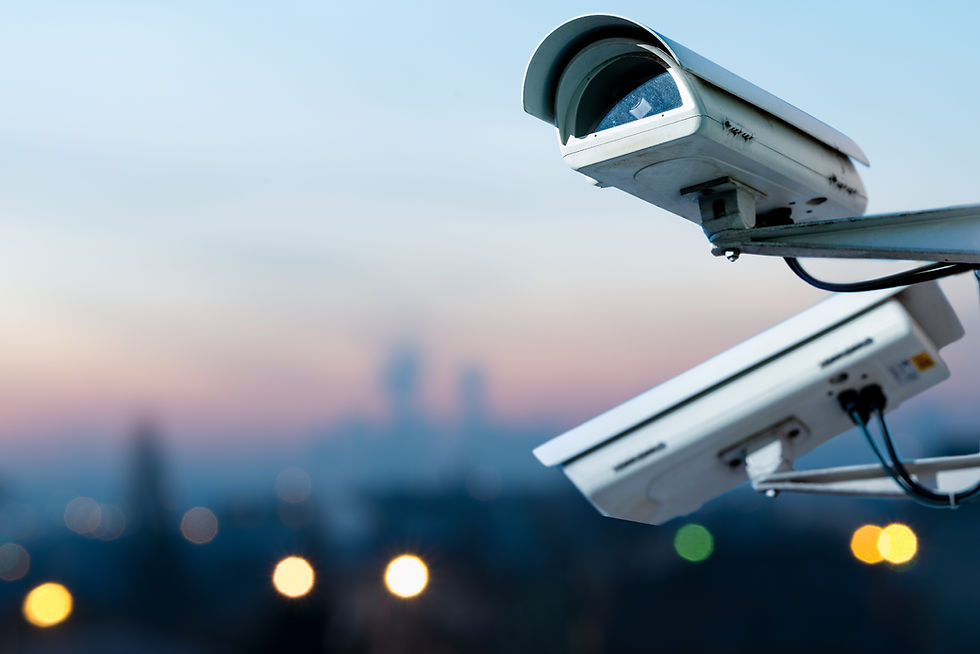CCTV 101: Understanding the Basics of Surveillance Cameras
- MB Security

- Feb 11
- 4 min read
Closed-circuit television (CCTV) systems have become an essential component of modern security strategies for businesses, government agencies, and private individuals. These systems provide continuous monitoring, deter criminal activity, and offer valuable evidence in case of security incidents. A well-implemented CCTV system enhances situational awareness, supports law enforcement, and provides documented proof of security breaches. Understanding how CCTV systems work, their applications, and their importance in safeguarding assets and personnel is crucial for effective security planning.
How CCTV Systems Work
CCTV systems consist of several key components that work together to provide a comprehensive surveillance solution:
Cameras: CCTV cameras serve as the system's eyes, capturing real-time footage of designated areas. They vary in specifications, including resolution, field of view, and special features such as night vision and motion detection. The placement of cameras is strategic to ensure full coverage and eliminate blind spots.
Transmission System: Whether wired or wireless, this system transmits video feeds to a central monitoring station. Wired connections, such as coaxial or fiber optic cables, offer reliability and high-quality feeds, while wireless solutions provide flexibility in camera placement and remote access.
Recording Device: Either a Digital Video Recorder (DVR) or a Network Video Recorder (NVR) stores footage for later review. DVRs work with analog cameras, converting footage into digital format, while NVRs are designed for IP cameras, storing high-resolution footage with better scalability.
Display Monitors: These screens allow security personnel or business owners to monitor live footage and review recorded data. Monitors can be placed in control rooms or accessed remotely via mobile devices or computers, ensuring security personnel can always oversee surveillance operations.
Types of CCTV Cameras
There are various types of CCTV cameras, each designed for specific environments and security requirements:
Dome Cameras: These cameras feature a dome-shaped casing, which makes it difficult for intruders to determine the direction of the lens. They provide wide-angle coverage and are commonly used indoors in areas such as retail stores, offices, and lobbies. The durable casing also protects against tampering.
Bullet Cameras: Recognized for their cylindrical shape, bullet cameras are designed for long-range surveillance. Their weather-resistant casings make them suitable for outdoor use, where they monitor parking lots, perimeters, and other large open areas. Their visibility acts as a deterrent to criminal activity.
PTZ (Pan-Tilt-Zoom) Cameras: These cameras provide operators with the ability to remotely control movement, zoom, and focus, allowing for active monitoring of large areas. PTZ cameras are often used in high-security locations such as airports, casinos, and government buildings.
IP Cameras: Internet Protocol (IP) cameras connect to a network, enabling remote viewing and management. These digital cameras offer higher resolution, advanced analytics, and integration with cloud storage solutions. They are widely used in modern security infrastructures.
Thermal Cameras: Designed to detect heat signatures, thermal cameras are highly effective in low-light or complete darkness. They are commonly deployed in critical infrastructure security, border surveillance, and search-and-rescue missions.
Applications of CCTV Systems
CCTV systems serve multiple purposes across various industries, enhancing security and operational efficiency.
In retail and commercial spaces, surveillance cameras help prevent shoplifting by monitoring customer behavior and providing video evidence in cases of theft or disputes. They also ensure employee safety and compliance with company policies. Industrial and manufacturing facilities benefit from CCTV systems by overseeing production lines, monitoring restricted areas, and improving workplace safety by detecting hazardous situations and ensuring regulatory compliance. Public spaces and government facilities utilize CCTV to enhance public safety, manage crowd control, monitor traffic patterns, and deter criminal activities in high-risk areas such as airports, train stations, and city centers. Residential use of CCTV systems allows homeowners to secure entry points such as doors, driveways, and yards. Smart home security systems integrate CCTV with mobile apps, allowing remote monitoring and instant alerts, giving homeowners peace of mind.
Benefits of Implementing a CCTV System
Installing a CCTV system provides several significant advantages for businesses and individuals.
Crime deterrence is one of the primary benefits, as the visible presence of security cameras discourages theft, vandalism, and unauthorized access. Criminals are less likely to target areas under surveillance. Real-time monitoring enables business owners and security teams to observe premises remotely, detecting suspicious activity and responding promptly to incidents.
Live feeds can be accessed on-site or through mobile applications, ensuring continuous surveillance. Legal and insurance benefits are another crucial advantage, as recorded footage serves as evidence in legal disputes, workplace incidents, and insurance claims. This documentation helps resolve conflicts efficiently and proves liability in accidents or criminal cases. Operational oversight is significantly enhanced with surveillance systems, as businesses can monitor employee behavior, ensure adherence to safety protocols, and improve productivity. CCTV also assists in maintaining quality control in industries such as manufacturing and logistics, where monitoring production processes is essential.
Overall
CCTV systems are an indispensable part of any security strategy, offering businesses and individuals increased protection and oversight. By understanding the different types of cameras, their applications, and their benefits, decision-makers can make informed choices about their surveillance needs. A well-planned CCTV system not only enhances security and promotes safety but also helps mitigate risks in today's increasingly complex threat landscape. Investing in a robust CCTV infrastructure ensures proactive security management and long-term operational efficiency.
-
For comprehensive security solutions tailored to your needs, Mulier Bellator Security offers expert consulting in physical security, cybersecurity, personnel security, and emergency preparedness. Contact us today to enhance your security posture and safeguard your assets. Protect. Prevent. Prevail.




Comments